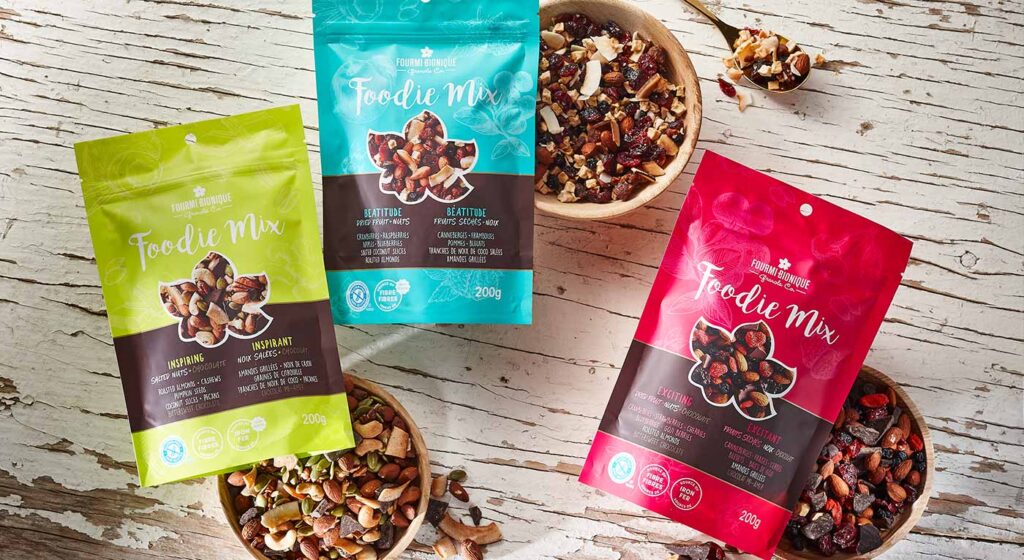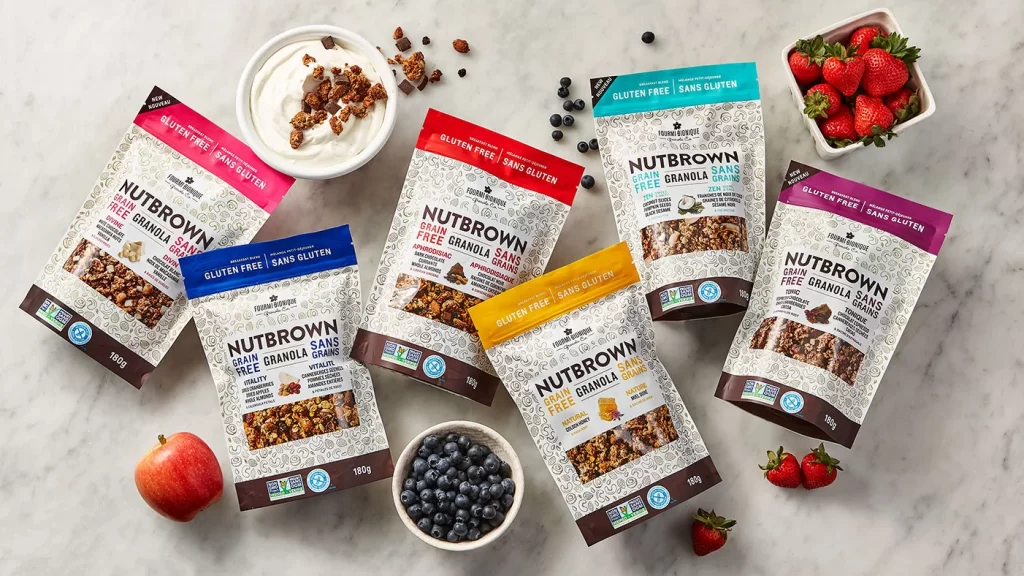La Fourmi is dedicated to producing granola, mueslis and snacks from natural, mostly local, organic and fair-trade ingredients. We are proud to offer you high-quality, nutritious and tasty products. But we know that the quality of our products extends beyond their content and includes how they are packaged.
That’s why we decided to become a certified B Corp and why we’re committed to exploring the most eco-friendly options throughout our products’ life cycle. Today, we’d like to share how we chose the best packaging for the quality of our products to ensure optimal shelf life, nutritional retention and environmental sustainability.
Plenty of Challenges
We faced several challenges when selecting packaging for our products. First, we wanted to find a pouch that would preserve the food optimally. The goal was to avoid altering our products’ quality and flavour and their ingredients’ nutritional properties.
We also wanted to use a more eco-friendly packaging when it came to food waste. So, we conducted studies to find the best packaging for our products in terms of shelf life, nutritional retention and environmental conservation.
Lastly, this packaging had to be cost-effective and recyclable. Quite a challenge!
To help our decision-making, we conducted a study with a specialized organization as part of our B Corp approach.
Available Options: Considering the Compostable
One of the things our customers often ask for is compostable pouches. It’s tempting to think that compostable pouches are the ideal solution for our product packaging because they can break down naturally without polluting the environment. However, after careful analysis, we found that compostable pouches aren’t optimal for our packaging.
First, it’s important to note that compostable bags are often confused with biodegradable bags, which break down into small pieces of plastic that continue to pollute the environment. Compostable bags, on the other hand, must be composted under specific conditions to decompose effectively, and they aren’t always composted properly.
Second, even if compostable bags are properly composted, they emit greenhouse gases as they decompose. So, even though they aren’t considered waste, they still negatively impact the environment.
Lastly, compostable bags don’t always preserve products optimally, which can lead to a short shelf life and food waste. Food waste has a significant impact on the environment in terms of the resources used to produce that food, transportation and waste.
So, we had to explore other options.
Plastic Bags: More Durable
To be clear, there are 7 different categories of plastic, each with its own advantages and disadvantages in terms of product preservation and recyclability.
- Polyethylene terephthalate (PET) is used for bottled water and soft drinks. It’s easy to recycle, but it can release contaminants when exposed to heat. So, it’s not ideal for storing our products because it lets in oxygen.
- High-density polyethylene (HDPE) is used for shopping bags and food containers. It, too, is easy to recycle but can release contaminants when exposed to heat. It is also less airtight than other materials, which can result in a shorter shelf life for our products.
- Polyvinyl chloride (PVC) is used for pipes and flooring. It’s difficult to recycle and can release harmful chemicals when burned. It also isn’t fit to store our products because it isn’t airtight and can let air and moisture in.
- Low-density polyethylene (LDPE) is used for freezer bags and plastic wrap. It’s easy to recycle but less airtight than other materials, which can result in a shorter shelf life for our products.
- Polypropylene (PP) is used for food storage boxes and grain packaging. It’s easy to recycle and relatively airtight but not suitable for the nature of our products.
- Polystyrene (PS) is used for Styrofoam cups and disposable plates. It’s difficult to recycle and can release harmful chemicals when burned. It’s not ideal for storing our products because it’s not airtight and can let in air and moisture.
- Other plastics include materials such as polycarbonate (PC), polytetrafluoroethylene (PTFE) and melamine. These materials have unique properties, such as high heat and corrosion resistance, but can be difficult to recycle given their multiple layers.
So, Why Choose #7 Plastic and Stand-Up Pouches?
After considering all packaging options, we felt that #7 plastic (PC, PTFE, melamine, etc.) and stand-up pouches were the best solutions for our products.
In fact, according to our studies, stand-up pouches have the best balance in terms of GHG emissions, compared to a cereal box with a bag for example. With #7 plastic (BPA free and recycled into certain components), these bags are resealable and more airtight thanks to the two layers that act as an oxygen and moisture barrier. This results in our products being better preserved, maintaining their nutritional profile and optimal flavour for up to 12 months.
Furthermore, these bags are not only recyclable but also lighter and easier to store and transport than other packaging options, reducing GHG emissions from transportation.
As a certified B Corp, we are committed to exploring packaging options that have the least environmental impact in our products’ life cycle (in terms of sourcing, composition, recycling or biodegradability). So, we conducted an analysis to determine that #7 plastic is the best option for our products and our commitment to the environment.
We’ve chosen the packaging that best suits our products to ensure optimal shelf life, nutritional retention and environmental conservation. We are a certified B Corp and committed to further investigating the most eco-friendly packaging options for our products. We want to reassure our customers that their health and the environment are major concerns for us and that we will continue to make informed decisions to provide the best possible products.
By purchasing our products, our customers may rest assured that they are choosing a healthy, eco-friendly and fair-trade product, while supporting a company committed to these values.


